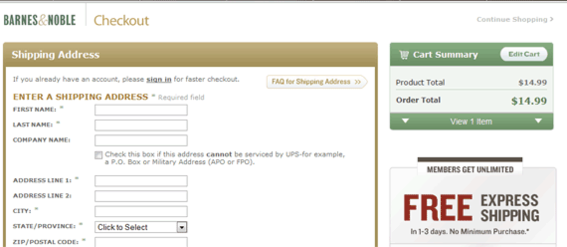The ecommerce shopping cart is a software package that accepts customer payment and shipping information and facilitates the distribution of that information to merchants, payment processors, or others.
At the surface, an ecommerce shopping cart is really something that every beginning online merchant intuitively recognizes. For example, almost no one would consider opening an online store without having made a few purchases online themselves.
In the course of buying books from Barnes & Noble or clothes from Gap, that new ecommerce entrepreneur no doubt encountered a shopping cart. From the consumer’s perspective, an ecommerce shopping cart may seem like little more than a web form, little different than an email newsletter subscription or an online registration form.

Example of a shopping cart page on Barnes & Noble.
In this article, I will describe a shopping cart, explain two basic categories of carts, and offer a few suggestions for selecting your cart.
A Cart’s True Nature
The common form of “shopping cart” describes a sort of specialized content management system that (1) stores product data; (2) provides an administration portal for catalog, order, and customer management; (3) renders product data, product categories, and website information for display to site visitors; (4) serves as the hub for on-site merchandising and cross selling, and (5) passes transactional data to a payment gateway or begins order processing itself.
As an illustration, imagine shopping at a big box store, like Walmart. At Walmart, you might grab a metal shopping cart and begin pushing it around the store. You look at various items on various shelves. You notice a discount sign or two. You place a few items in your metal shopping cart. Eventually, you walk up to a register and pay your bill.
In ecommerce, a shopping cart is certainly like the metal shopping cart you imagined you were pushing around Walmart, but it is also the shelves, the building, the discount sign, the cash register, and in many cases the credit card machine communicating with your bank. Effectively, an ecommerce shopping cart is an online store.
Two Basic Types
Ecommerce shopping carts can generally be described as “licensed” or “hosted.” These terms are not terribly helpful since, essentially, all online shopping carts have some sort of a license and all are hosted on a web server whether that server is in Bangladesh or your basement.
Rather than being descriptive, the terms denote how one pays for using the shopping cart software.
In the “licensed” shopping cart model, a merchant pays a license fee (often a one-time fee), and then takes possession of the software. Within reason, the merchant may place the software on any web server and, in most cases, may modify or customize the shopping cart software. If a merchant wants to change web servers, the merchant can take the shopping cart.
The “hosted” shopping cart model is a form of software as a service (SaaS). In this scenario, the merchant pays a recurring monthly fee for access to the software. The merchant does not choose the web server’s configuration or location, and the merchant may in no way modify or customize the shopping cart software.
Each model has merit. For example, hosted shopping carts are often thought of as being easy for beginning merchants, since the shopping cart provide makes most decisions on the merchant’s behalf and often provides a simple interface for non-technical shop owners. On the other hand, a more advanced merchant may want the freedom associated with a licensed cart, which can often lend itself to a better user experience and may be less expensive over all.
Finally, there are some “free” licensed carts. With these carts, one will still need to either own and maintain a web server or rent a web server, but the software itself is free.
Which Cart to Use
With broad strokes, I have described shopping cart software as the whole online store. I have discussed the two ways you might pay for shopping carts, but I have only scratched the surface. I have provided concepts that I hope illuminate, but that I know are not enough.
Knowing what a shopping cart does or is must be supplemented with an understanding of how it does it. And for this you will need to evaluate each cart individually.
But there are some clues or hints that I can provide which may help you choose a shopping cart wisely.
- The price should be proportional to your sales. Some shopping carts are free, some cost $1 million per year (or so I am told).
- Look at other sites the use the shopping cart. If you like the look and feel of these other stores, then you may like the cart. If you think they look like are all the same, you may not like the cart.
- Try out the administration panel. Does it seem like work flow will be easy? Do you understand it?




